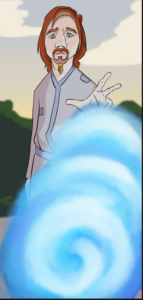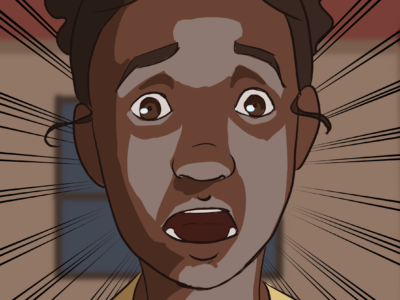
So, yesterday I uploaded “In which Mira learns a lesson pt 5” which concludes chapter 2. There are a lot of hand pictures on my phone. I use Pinterest to find photos for reference, but sometimes it is so hard to find something doing the thing at the right angle! Also, I can pose the body, but I have no idea how the folds in their clothing work.
However, I love making this webcomic. I have learned a lot. I have practiced facial expressions, posing, face angles, hands, and backgrounds. I also tend to over soften a piece, so using cell shading has changed how I see shading and lighting. I feel I am a better artist on page 25 of chapter two than I was on page 1, or chapter 1. And there’s more to go.

Do you need college to be an artist?
No*. Pencil and paper is a good place to start, but pick a medium and have fun. To be a professional artist, the answer is still no. There are successful Youtube artists and people on Instagram that are doing very well with no college education (at least in art). These artist have a wide range of styles, from cartoony to hyper-realism. Their set up ranges as well. Jazza tries a large range of mediums and new toys, ranging from trying traditional mediums like oil paint and marble sculpting to painting with food and laser designs. DrawingWiffWaffles goes for trying new mediums or coming up with interesting design requirements. She opens subscription boxes or creates art based on food or colors. Other artists stick with one medium, markers or watercolors, exploring the full range of what is possible. Sakimichan uses Patreon to create fanart and personal art, available through subscription. The more one pays, the more one gets, such as high resolution pictures, not safe for work variations, books, and how to videos.
* Here’s the exception.
1: Gallery artists. The artists I have mentioned before here, are popular on social media platforms and generate income by creating content, using Patreon, and selling merchandise. Gallery artists show off their work in galleries and events, which then sells at a high price to individual consumers or museums. This can become a game of who you know, in which art school is helpful.
2. Graphic Design. I can paint people. I cannot make a great website. Graphic design is a wide term including website design, logo design, creating flyers or magazine layouts and the visuals for social media posts, packaging, and occasionally some other things like photography. Fine art skills like drawing and color theory are helpful, but a fine artist and graphic designer are different. Typography? I know two fonts and what sans seins means. A lot of graphic design jobs will require a bachelor’s degree or a good deal of experience. I know enough about graphic design to know I’m not good at, could learn it, and don’t know how to get better without attending school.
2b: Interior design. I just know there’s a lot to know that I don’t know.

3. Art teacher. Certification requires a bachelor’s degree, preferably art education, and a content area test. Certification varies depending on state (for example having a studio art degree but completing education courses and the test). Community colleges require a masters degree in art.*
*I know 2 bassoon teachers who taught at a university with only a bachelors degree, but they had big deal experience to make up for not having a higher degree.
4. Concept Art/Illustrator. This is in between. I believe a strong portfolio will outweigh not having a degree. It will take intense self study, especially for concept art, but I believe it is possible. Illustration has such a wide variety of styles that being consistent in one or two styles will be more beneficial than attending school.
Practice makes perfect…sort of. Perfect practice makes perfect. Part of being a musician is learning how to practice, just like being an artist. “Draw every day” or “draw a lot” is thrown around. Yes, drawing often helps, but drawing thoughtfully helps more.
Here’s how I got better at drawing (I’m not great, but I do alright).
1. Draw from real life (even if you have a style). If that is not possible, draw from a good photo. Start with 1 light source and sharp shadows and highlights. (cute instagram photos are probably not good to start with. Add “reference” to a search on google or pinterest or use a pose site). Mirrors, smart phone cameras, and yourself are great for modeling.
2. Watch other people create art. Learn from them then try the technique. If you do not apply the technique, you have not learned it. Sometimes learning from others means learning what we don’t like or what doesn’t work. You may also copy others artists. DISCLAIMER: do not post it as your own. Best practice is to keep it as a study and not share it OR ask the artist before sharing it, with the disclaimer it is a study. Obviously you don’t have to ask Rembrandt, but still state it’s a study. This is also how you discover your style.
3. Analyze your art work. How is mine different from the original? Being able to copy what you see is an important skill. Being able to apply that to your art is also important. If you want to learn how to draw cats, draw a cat as it is, try to get as close to capturing it as possible. Then try to redraw it in your style. How do I feel about this technique? Does it work with my style, does it make creating easier, does it improve my art?
